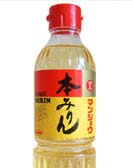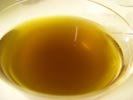 Serves 4, vegan Serves 4, vegan |
||
|
Tempura originated from the Portuguese missionaries that visited Japan during the 16th Century
and has adapted to the tastes of the Japanese people to become a wholly Japanese dish today. Essentially tempura should be light, fluffy and non greasy and usually includes egg white, flour and iced water but I have developed a vegan version over the years that I now almost always use instead. Use any vegetables you wish. I used long thin slices in this recipe because I like the look of it. |
||
|
For the batter 3 tbsp plain flour 1 tbsp cornflour ½ teaspoon salt 1 tbsp vegetable oil 150ml (5floz) water 1 large sweet potato 1 courgette |
Make the batter first by mixing the ingredients in a bowl and whisking it all together. The
oil is essential for making the batter more crispy so don't leave it out. Peel the sweet potato and using a potato peeler peel off long strips of each of the potato and the courgette. |
 |
|
Heat some oil to about 180°C (356°F) in wok or an electric deep fat fryer. Dip the vegetables in the batter and deep fry them in small batches until the batter is crispy. Drain on kitchen paper. There is a traditional tempura dipping sauce but to be honest it is great just served with salt and lemon juice or a blob of mayonnaise. I have included the dipping sauce recipe below if you wish to use it. Tentsuyu sauce 225 ml (1 cup) dashi stock 3 tbsp soy sauce 2 tbsp mirin 3 teaspoons sugar Bring the dashi to the boil and add the other ingredients. Stir together and simmer for a few minutes and then take it off the heat. Serve hot or cold. This sauce will keep for days in the fridge. |
 |
|



